When last we left our heros (Me, and a few hundred of my closest friends in uniform), it was 1995 and they were on the Northern Coast of Haiti.
Task Force 4-87 IN (Catamounts) was the one US Battalion assigned to the multinational brigade headed by the Command staff of 3rd Brigade 25th ID. The brigade Headquarters were in town. The Soldiers were stationed outside the main city in the vicinity of the airfield.
The fence surrounded our base camp, with two layers of chain-link and concertina wire. Twenty foot high towers (estimate) stood at regular intervals around the camp and also around the airfield. In the center of the base camp was the almighty Tactical Operations Center (TOC), where Battalion staff tracked current operations and planned new operations. At the TOC we would receive our missions in operations order (OPORD) format. After a mission, we would return to the TOC for the after action reviews (AAR). Additional towers overlooked portions of the airfield.
Our life would consist of a simple cycle: One week on tower duty, one week for out-of-sector missions, one week for presence patrolling in Camp Haitien, one week for quick reaction force missions. Each of the four companies would cover one of the jobs each week. In addition to the transportation assets of the headquarters company, we had a slice of Air Defense Artillery under the leadership of my classmate Jay Rose. The ADA platoon had their own vehicles, thus their motto:
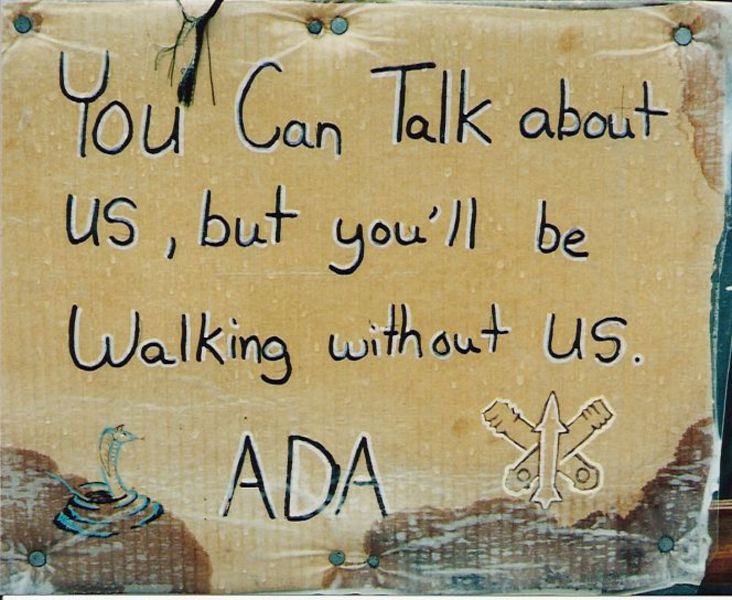
Presence Patrolling
The way to control ground is to put A Soldier’s Boots on it. In Camp Hatien this meant presence patrolling. The town was divided into sectors. Some of the patrols were so close that we could walk out the front gate, but most were a short ride away.
I seem to remember the area right outside the gate best. Many of the houses had been built recently. If you look at the satellite photo you can see how the whole area of the base camp has been covered over by the new buildings. Haiti is overpopulated. One effect is that there are very few trees, certainly not enough to use as building material. The main building material was mud. Mud brick houses went up daily as we watched. One section of town extended right out into the mudflats on the edge of the sea. If you look at the Western Edge of the town, you can see the water around the buildings. On one Patrol I watched a man up to his waist in Seawater digging and prepping his house.
On one early presence patrol, just over the bridge into the old part of town, sparks on the sidewalk drew my attention. A man was welding together a bed frame. The component parts were the pickets that we used for concertina wire. I briefly contemplated making a scene, as the posts were clearly stolen. It would have been impossible to prove, and made us look like idiots for pressing the point. I was impressed with the industry. A little bit of security and people looked for ways to improve their lives any way they could.
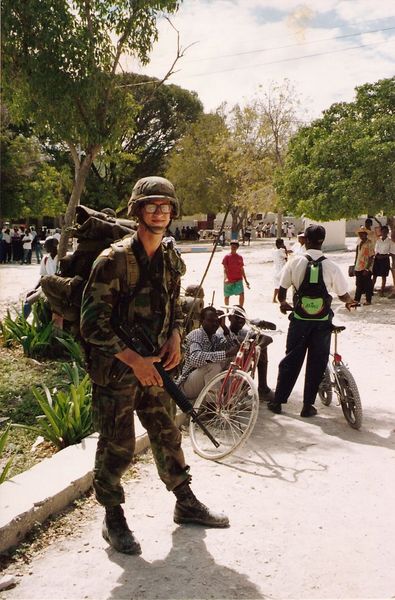
Presence patrolling after a rain meant walking through sewerage. The biggest threat we suffered through the whole time we were in Haiti was disease. We took malaria pills regularly, but even still, the Company First Sargent contracted malaria at the end of the mission. We had standing orders not to eat any food off of the local economy. We had been warned how bad the AIDS epidemic had become in Haiti.
We quickly got used to the local greeting, which I will attempt to phoneticize here: “Sac Pa Seyâ€. I have no idea what this means. Say this to any Haitian you meet and you should be greeted with a smile, and the appropriate response of “Na Boo Ley.†I don’t know what that means, either.

One advantage the US Army has over most militaries of the world is a wide distribution of night vision. Since many of the neighborhoods in Cap Hatien had minimal or no electricity, they were poorly lit during our night patrols. We would walk through the night as the only ones who could see, a very surreal experience. The whole world was green. One night we passed a disco, the bright light coming out the door causing a brief whiteout of the night vision device. More memorable was the night we patrolled past a very public viewing of a porn film. A squad with machetes could have ambushed us at that point, as just about every eye was focused on the screen.
On some of the later patrols, I spent a good amount of time taking pictures. I wanted to record what we had seen to use for learning purposes, as well as to preserve the experience. I think this did not sit too well with my guys. In retrospect, I would have been better off, and more doctrinally correct, to specify one of the men in the platoon as the cameraman, and have it a rotating responsibility. It would have kept me out of the action and in the supervisor role.
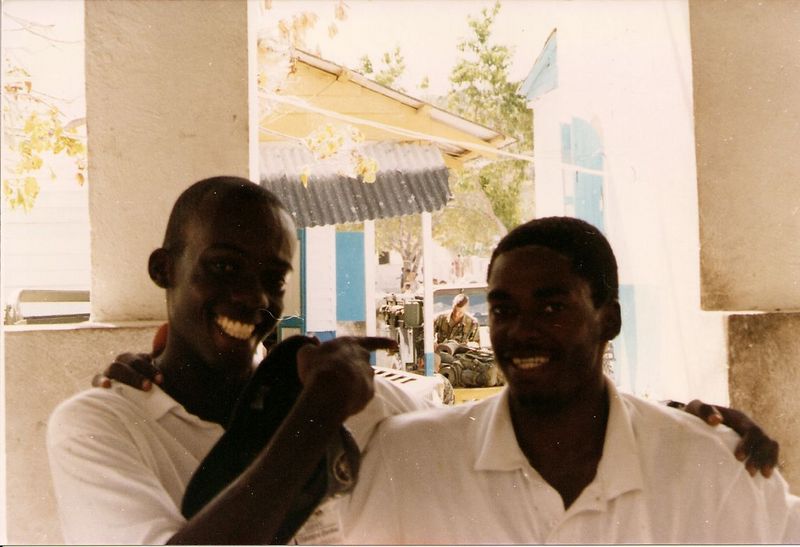
Out of Sector Missions
The out of sector missions were the most memorable portions of the deployment. There were three big ones. I forget the order, but I think it was the Ricebowl, Fort Liberty, and Isle Gonaives.
The Ricebowl refers to the Artibonite River Valley. Since it has a high quantity of rice production, it is one of the most contested lands in Haiti. The one United States Soldier that was killed by hostile fire happened in this area. We came down to do presence patrolling. The first trip was a leaders reconnaissance with, The CO, 1SG, and Platoon Leaders. We flew down on a Blackhawk. This was my first view of the countryside beyond Camp Haitien, and it was enlightening. Once we flew beyond the very narrow coastal plain, the terrain grew very mountainous. Vast portions of the countryside had been stripped of trees. Villages were few and far between. I’d seen how poor Haiti was in the urban areas, now I got to see the rural poverty.
We landed near the main city: Gonaives. Army Special Forces had been operating in the area since the initial invasion. The ‘C’ Team (Equivalent to a Battalion) had set up Headquarters in a building in the center of the city. We went through a brief on the situation. The land was valuable for rice production. Property had been confiscated and redistributed so many times over the past several administrations that sorting out who owned what was impossible for some tracts of land. The Haitians had resorted to violence. We established sectors, made contact with the SF representatives for each of our areas, and saw a tiny bit of Gonaives, mostly going to the ‘B’ teams Headquarters.
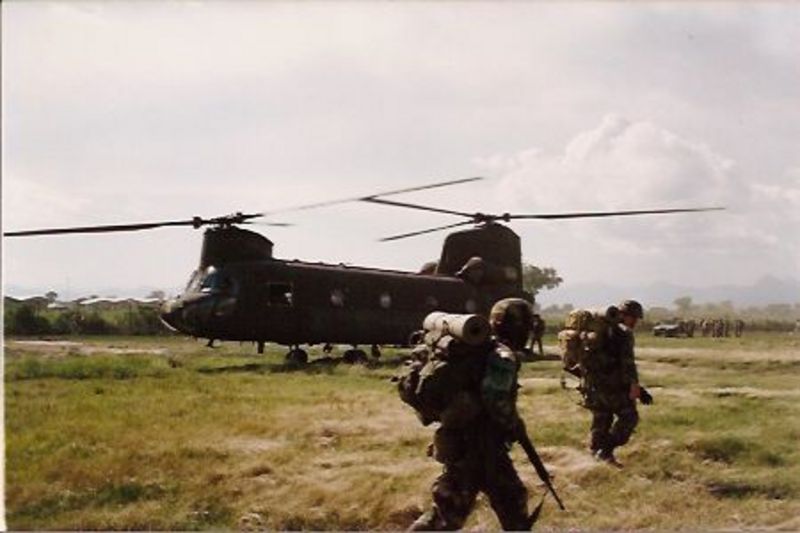
The movement of the main body of troops was a little more significant. We had two Chinook helicopters and one Blackhawk, which was not quite enough to make it in one trip. The was a painful movement for me as I was suffering from what I later found out to be a Sinus infection. Each change of elevation felt like the inflation of a balloon inside my face. We certainly made a big entrance. After hitting the ground like a combat operation, we sat and waited for the next load of helicopters, about an hour and a half or so round trip. Not very tactically secure.
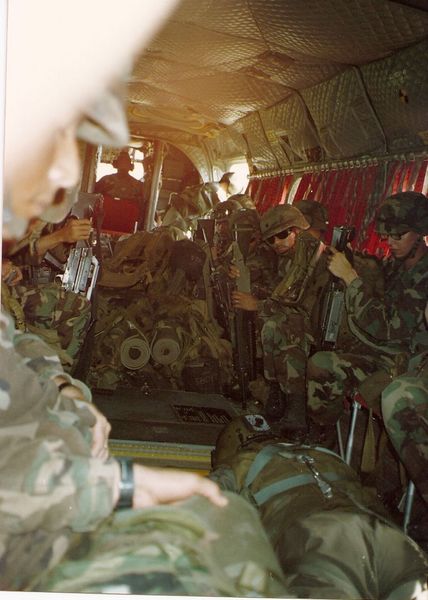
We set up a patrol base in an open air structure on the edge of the town. The town was built up on ground a few feet above the level of the rice paddies, which spread out in all directions. We did several patrols through that town, then got in trucks, drove to another, and repeated. The travel from town to town and while out patrolling was along dikes between adjoining fields. At one point, a dike collapsed under a HMMWV from another platoon. One NCO injured his arm getting the other soldiers out.
Many of the Haitians were unsure of what to make of us. We were threatening looking, but peaceful. many of the people bathed out in the open. We would walk by woman bare to the waist, some of who didn’t bother to cover up as we passed. The expression “Potatoes in a Sock” spread around to describe the well endowed exposed women that could have used a support bra.
One patrol base was the garage area of a well to do house. While we were setting up, the Special Forces Liaison showed up with a crate of cokes, frosty cold. These were a pleasant sight in the blazing sun. We had standing orders to not eat or drink anything off the economy. I wisely avoided bringing this up, not asking about the cokes origin. If I had refused them, I would have gotten myself lynched.
Our second out of sector mission was to Fort Liberte’ way on over near the Dominican Border. To get there, we had a vehicle convoy. Since I was not the convoy commander (we had to have an O-4 supervise all out of sector missions) I decided to take the lead vehicle instead. Ostensibly this was to better navigate. This had the added benefit of getting me out in front of the dust kicked up by all of the other vehicles. The road traversed the northern coastal plain of Haiti. After passing out of our regular area of operations, we passed through a smattering of towns. The buildings were mostly mud brick and surrounded by a wall topped with broken bottles.
Halfway to Fort Liberty was a town that I have since learned was Trau du Nord. On the far side of the town was a bridge. As we approached, I realized that the bridge was badly deteriorating and probably unsafe. I told my driver to stop. He kept going. I repeated the order louder, to no effect. A third time, almost shouted also failed to stop him and our vehicle. I watched in horror as he drove right over to the far side of the bridge, which, thankfully, supported our weight. When I got to the far side, I was able to get my driver to stop. I looked back at the rest of the convoy, stopped on the western edge of the bridge. The voice of our Battalion XO dryly informed me that Division Engineers had determined the bridge to be unable to support the weight of a HMMWV. I asked him if he wanted me to come back? It turns out that there was a fording sight on the river below the bridge. He lead the rest of the convoy down and around that way and we continued on. In the after action review I would ask why that particular piece of information wasn’t in the route briefing.
The remainder of the mission was uneventful. We posted security at an official building, did a little patrolling, the usual. The only detail left in my mind is how picturesque the old fort was, looking out over the Carribean. On the return trip, we all used the fording site. I remember passing a funeral procession in a town just outside of Cap Hatien, complete with wailing mourners. I remember thinking how much energy must go into funerals in a land with such a high death rate.
The third mission was to the Isle de Gonaives in the center of the great bay that defines Haiti. The landing zone for the Chinooks was the beach, which means that the propeller induced blast could clean the pain off of sheet metal. The island was quiet. We Patrolled around the only major town, and I got some great photos. I got bored, and split my squads up, something I had been warned not to do, but I wanted to cover more area than we had to date, and I wanted to give my squad leaders some more leeway in patrolling. My company 1SG called me on it, and I downplayed the degree of separation between the squads. He was right, I was wrong, and I shouldn’t have done it.
The thing that strikes me is how vulnerable we were compared to a combat patrol. In presence patrolling, you want everyone to know you are there. The reason why I joined the light infantry was the exact opposite: strike silently and fade away before you can be found. I think If I had realized the reality of US operations, I would have gone Mech Infantry or Armor. You want me to make my presence known? Let me to it in a Bradley or an Abrams.
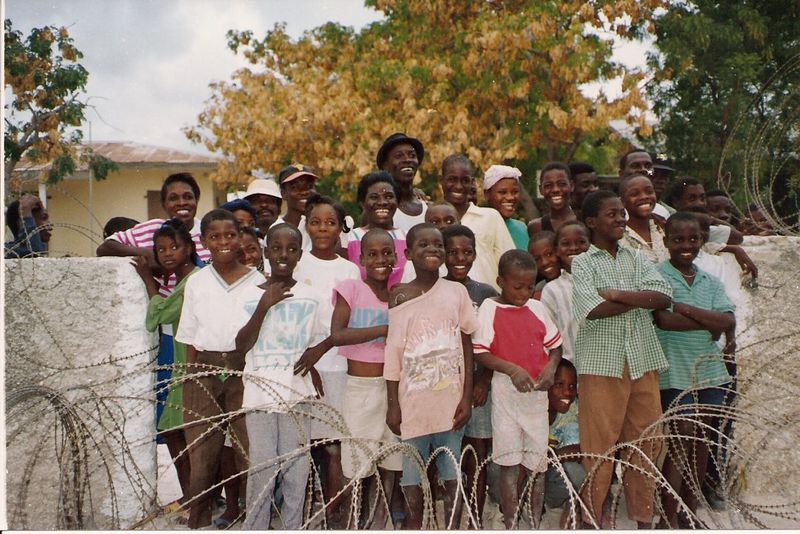
Our unofficial motto was “25th Light Infantry Division: Too Light to Fight, too Heavy to Run”. At some point, the Army got rid of standard infantry and moved to light infantry. This was a reaction to Vietnam, where most missions were carried out so far in the Jungle that Vehicles were useless. This does not make sense for most of the world. They also decided that a light infantry platoon only needed two M60 (7.62 Caliber, full metal jacket) Machine guns as opposed to the three you find in Airborne, Ranger, and Straight Infantry Platoons. Lost the weapons squad leader as well. And the Company Mortars, since they are now human carried as opposed to vehicle carried went from 81s down to 60mm. A 60 MM Mortar is basically a grenade, just thrown by someone with a really good arm. The Stryker Brigades seem to be a return to standard Infantry, just with a better delivery system than a deuce-and-a-half. I wonder if they upped the weapons back to standard infantry levels as well? Wouldn’t have mattered in Haiti, as we didn’t carry anything heavier than a SAW.
Tower Duty
The least interesting mission was tower duty. For a week, my soldier’s stood in towers an looked at the landscape. We had four shifts of 8 hours each, so that your sleep routine got completely messed up, but at least you got to eat in the Chow hall for a meal or two each day. Platoon and Company leadership stayed in the company headquarters tent, and periodically went around and inspected the soldiers on the towers. Probably no event so decided the non-illustriousness of my military career than the boredom inflicted by tower duty.
I originally had grand plans for tower duty: we were going to make a sand model of the base. Then I was going to plot each of the towers on the map based on their 10 digit grid coordinates. Somehow, I never got around to either of these things. It seemed to me that the HHC commander, who was also the garrison commander, should have to do these things. I never offered.
Tower duty is boredom. Tower duty is the kind of boredom that turns good soldiers into bad soldiers. Two anecdotes reflect this best. Once when checking towers I climbed up the short ladder and found one of the two guards sitting down with his rifle on the floor. I remember thinking that I should be outraged, but I empathized too deeply with the effect to rip the guy to shreds the way the situation really called for. I forget how I actually responded, but I suspect that the soldier was back on his feet pulling security before I left.
Far more damning was my own behavior. After several rounds of guard towers, I fell to one of the most seductive of all brain drugs: a vidoe game. In my case it was Sid Meiers Civilization II. I went so far as to write my first pascal program since graduation, to read a file, split it into two halves, and then reassemble the file from the component parts. I wrote this in order to copy the binary form one computer to another. From then on, when I wasn’t inspecting towers, I played Civ-II. I was so enthralled in the game that the Battalion Commander was able so stand behind me and watch me play for several minutes before I realized. I guess he told the rest of the people in the tent not to alert me. I am fairly sure that I would have reacted to someone calling the tent to order, no video game trance has that strong a hold on me. Still, I looked like an ass, though he never talked to me about it afterwards.
Near the end of our tour, the locals showed that they recognized our rank structure. During tower inspection, we often talked with the locals across the fence. “Lieutenant-man” called one local girl from the far side of the wire “when you go back to Hawaii, you take me with you.”
Quick Reaction Force (QRF):
The week of QRF duty was mostly a rest week. We had our gear stowed and ready to roll, but unless something happened, we were just siting around on call. The NCOs trained their teams and squads, and people caught up on rest. Every now and then we got called up to do something inside the city. Usually that something involved one of two valuable resources: food or electricity. The food was controlled a distribution center a few blocks down from our base camp. Other platoons spent a significant amount of time there, but we never did. More often, we were at camp Haitien’s power generating station. If the people who operated the station felt threatened, they would leave. This caused a blackout over the city. We often went there without any seeming cause. Just our presence seemed to calm the operators, keep the power going for another day. The equipment looked like something out of a steam-punk graphic novel. I am still not sure how they kept it going.
Another QRF mission still astounds me to this day. We were called out to the center of the city, to the site of the abandoned police barracks. The 10th Mountain unit in the area had their only gun battle here during their entry into the city.
Recreation
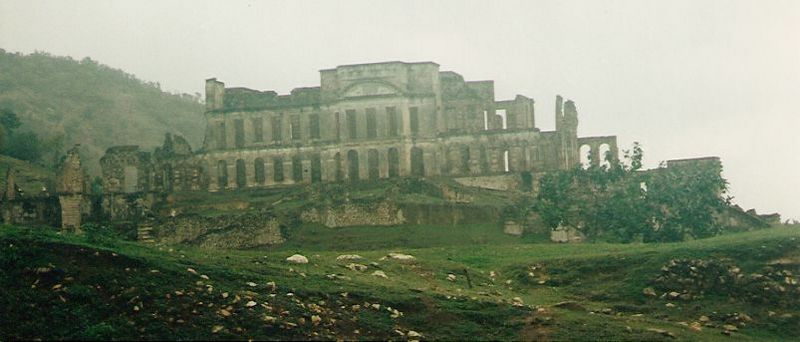
After some time in country we got a vacation day: a trip to The Citadel Laferri. Read the history of this amazing place. The trip was planned with the same degree of detail as an out of sector mission. A vehicle convoy took us up the road into parts of Haiti that were different from what we had seen before, quaint mountain villages that so desired to once again turn into tourist traps. We passed the ruins of the old palace, ghostly in the fog. I rode an old mule up from the end of the road to the citadel itself, and did the tourist thing. Very few photos turned out well due to the fog. I enjoyed the irony of riding a mule while wearing a Kevlar and carrying an M-16.
Plane on a Blackhawk
Rich Russo was one of my fellow Platoon Leaders. Like me, he had been in the Computer Science department at West Point. Like me, he was a (Ranger) tabless bastard in the Infantry. Rich had a couple of interesting events happen to him while a Platoon Leader in Haiti. One one foot patrol in Cap Hatien, some of his soldiers happened to look into the local cemetery and saw dead bodies stacked there. Battalion made him and his platoon pull the pile of bodies apart and catalog what they found; truly gruesome work. It turns out they were thrown there if they dies while patients in the hospital. Rich confessed to having nightmares of the process months afterwards.
Rich also impressed on me how he “Got” the army, in a way I never did. While prepping for a patrol, he inspected the men in his platoon. He had one pull out his bay9onet, which had rust on it. It was the kind of detail that we would have been certain to inspect back at West Point, in a dress uniform, but that would never have occurred to me to do in BDUs. In some one way it is an inane detail, but it does show if soldiers are truly caring for their equipment. Other good points were the inspection of ammo inside the magazines, looking for mud on shovels(e-tools) and so on.He managed a degree of respect from his NCOs that I never got from mine. It was a far cry from my PSG blowing me off when I was trying to get accountability of my platoons night vision devices.
Rich and his platoon got a great out of sector mission. They pulled security on a beach in Northern Haiti. Once the perimeter was secured, a boatload of tourists from a cruise ship pulled up. The tourists paired off and started having sex on the beach. Rich said the majority of his time was spent turning his guys around, facing them out to pull security. He was later credited with “Helping to return tourism to Haiti.”
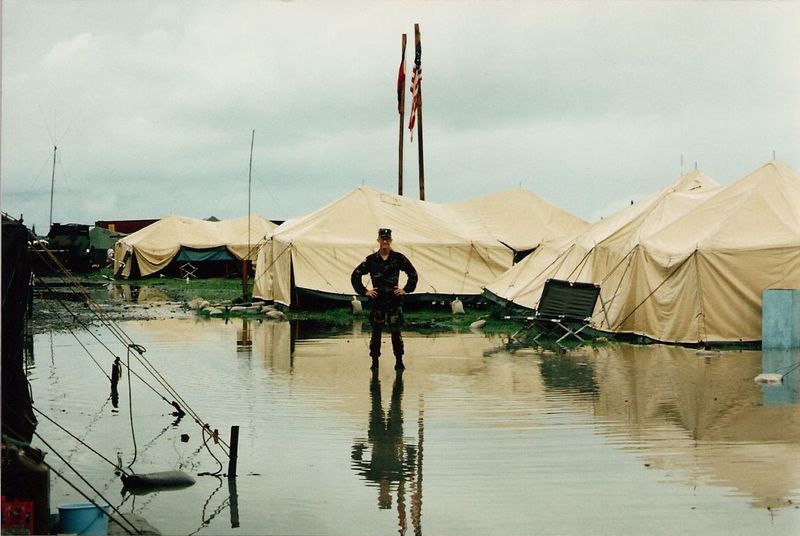
Life in the Base Camp
Since the 10th Mountain Division had been in country for 3 months already, the base camp was pretty well established. A fence surrounded a graveled site with GP Medium tents pitched on Pallets. Brown and Root was running the chow-hall. Thus, we each had 3 hots and a cot. A water desalinization process allowed us to have hot showers that were free from the most debilitating of Haitian microbes. Water was in short supply, and we were often reminded to keep showers short. The HHC Commander one scolded me for not turning off the running water while brushing my teeth.
The back portion of the company command tent was dedicated to supply. In addition to housing things such as rations and repair parts, it served as our weapons locker. However, the check out procedure was sufficiently time consuming that we rarely took advantage of the option to store our rifle there. That meant that we had to carry them around with us or find another soldier to watch them 24-7. The squads had racks set up in their tent. They would stack arms and post a guard. We had no such luxury as Lieutenants. Since there were only three of us in our tent (the Platoon Leaders) we had to make due. The other two guys took to locking their rifles in the trunk. This was technically forbidden. I never did this. Still my natural tendency to run off and forget things bit me in the ass. I left my rifle on my bunk one day and left the tent. It was found by LTC Glover. The was nail two in the coffin of my Army career. Yes, I should have just piggy backed with one of the squads and left my rifle in their tent. I was trying to do the right thing in not burdening my soldiers with my equipment. But I was lazy as well. But the damn Battalion Commander? Pretty bad luck on my part.
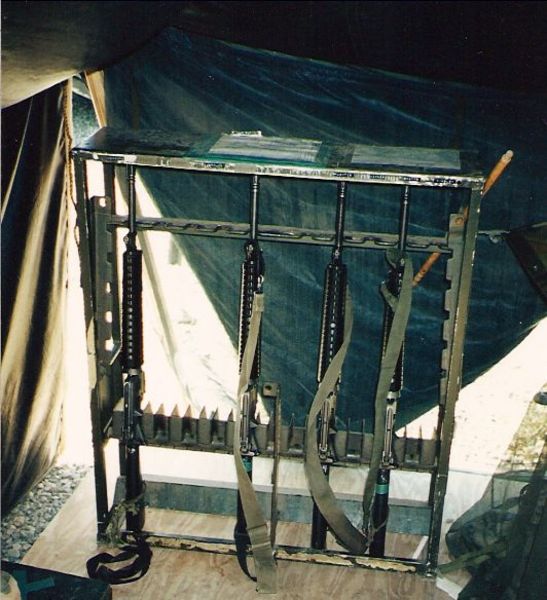
The towers along the airfield had the additional mission to provide security for our helicopters. The aircraft, mostly Blackhawks, were parked on the grass field about 150 feet west of the runway . The runway itself was a work of art: at some point in the past it had been extended, but the ground had not been leveled and a ramp of about two feet in elevation existed about a third of the way down. Near the end of the deployment, one of the soldiers indicated that I should go out to the runway to have a look. A plane coming in for a landing had blown a tire, and hooked a right turn. I don’t know if it hit the ramp on landing, but I’ve always assumed so. The plane was headed straight for the towers, but fortunately , one of the helicopters stopped it. There was something so comical about a half maintained aircraft parked on top of a 6 million dollar Blackhawk.
Some of the other officers were also into music. They tried tried to form a little A-Capella group. My Heart really wasn’t in it. One of the outcomes was that I became better friends with Spense Wieman. We would remain friends once we returned to Hawaii and were assigned to different units.
About two months after we arrived, the rains came. The camp was fairly low and flat. Even with the gravel base, the water didn’t run off. We had huge puddles of standing water. The pallets kept us dry in our tents, and wooden walkways soon appeared connecting various portions of the base camp.
Tarantulas are a fact of life in Camp Haitien. I chased one down with a HMMWV across the airfield one evening while checking on my guys in the towers. On another day, one of the NCOs showed off one he had killed. He used a knife to pry up the fang, which was over a centimeter long. Gave me an new respect for the hairy beasts.
A Report of Survey is an army investigation into a crash. One officer in the Battalion gets tagged as the report of survey officer when something gets broken. In my case, it was the front hood of a HMMWV (Made out of Fiberglass) that got wrecked when a soldier made a turn in Cap Hatien and hit a post. By the Army’s definition, the responsibility devolved to the driver at junior enlisted, and the Vehicle Commander (An E-5 if I remember correctly). The driver had misjudged the space and hit the pole. However, I remember feeling distinctly pissed at the situation once I looked into it. As a vehicle commander, you can often find yourself at the mercy of your driver’s experience. In this case, the driver was a kid who didn’t even have a civilian driver’s license before the deployment. To me, this constituted a lack of judgment on selecting the driver, which had been done under the supervision of the HHC commander. Really all I wanted to do was bury the case. Things get broken on deployment and I really didn’t think it was right to dock these soldier’s pay over this. That was my finding as the survey officer. Don’t know what ever became of it.
Power for our base camp came off the grid, but was backed up by generators. The transformer for the system was outside the main base camp near the intersection with the main road. One day we had a power outage. Shortly thereafter news came back to the power outage was caused by a goat getting into the transformer and nibbling on the wires. We lost power. The Goat was fried.
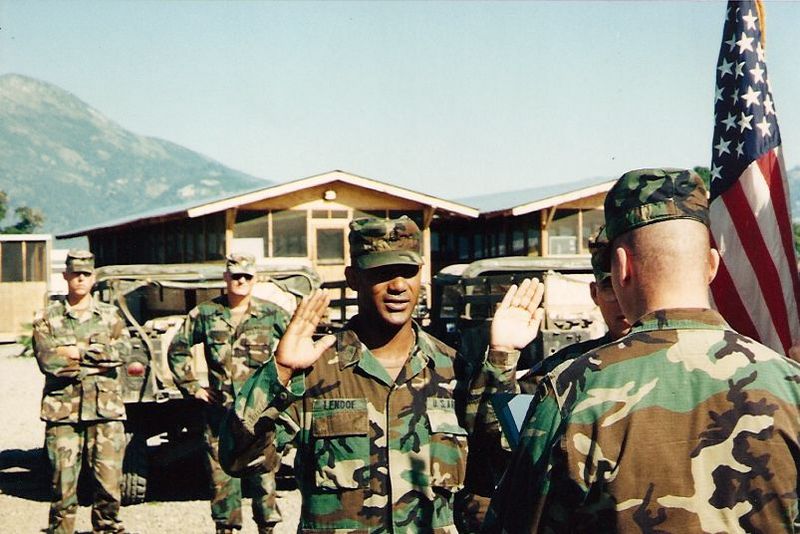
In an attempt to reduce violence in the area, the Army instituted a program where it would buy firearms for the general public. We staffed a tent with armed guards (Us) and a huge cash-box. Each individual was escorted in. We’d inspect the weapon and pay them if it was deemed to be a real threat. The Haitiens brought in a wide array of interesting items. There were many tear gas grenades with US Army markings on them. One man brought in a beautiful shotgun that some of the soldiers wanted to take home for hunting back in the states. Several toy guns were turned away. The most interesting find was a rusted relic from the late 1800s: a lever action winchester. There is no way the weapon could be made functional, but it had historical value.
Port-au-Prince
I forget what the mission was that got me down to Port-au-Prince (PaP). The only scene of actual violence I witnessed while in Haiti happened as I walked from the airfield to the base camp. A local man made to assault a soldier and the soldier had to detain him. The man was unarmed.
While down there, I did meet up with two of my former commanders: CPT DiChairo and LTC Caldwell. The seemed genuinely glad to see me. Both were doing well working in the Division Command center. I know I was down there long enough to go for a run a couple of times. The PX was much better established than our rinky-dink shop up at Camp Catamount. There did seem to be lot of discussion of Dominican Cigars.being purchased and shipped home.
I also saw an enlisted woman I knew from the Jewish Chapel down at Pearl Harbor. She was married to another soldier and they were both stationed there in Pap. I remember talking to her supervisor. We had a strict no sex rule for the deployment due both to the high Aids and disease rate in Haiti as well as a goal to minimize any inappropriate behavior on the part of our soldiers. This particular couple seemed to have been granted an unofficial exemption, which was just grudgingly accepted.
To Be Continued:
The final installment will cover our departure from Cap Haitien.

Adam – what a great account of our time in Haiti. I love the picture of you in the middle of the puddle we called a base camp! Hope you are doing well.
Actually, Rich, I wasn’t walking on water. That was Al Garcia, the other PL in my company,. I took the photo.
Wow. I remember that place so well. and reading your blog is refreshing…do you have more pics?
Hey..I got back in..Im going to be a Truck driver. (88m) At 41.
Damn Kris. You shame me. May your time over there be boring.
Hiii… Sac Pa Sey (really spelled Sak Passe) means Whats Up or what happening…
Nap Boo Ley (really spelled Nap Bole) We chilling…
If you need any words translated just send me an email!!
Jenn
LOL you jinxed me..they sent me to Korea. And it sucks!!! I really miss HAWAII!
Heh…all I wanted was for you to be safe if the sent you down range. Couldn’t you get 25th ID in your contract?
Anyways, as I recall, Korea was just a year. Do you get your pick of posts after that?
They said I get to pick..but it will prob. be a conus assignment..my luck it will be Ft. Drum. No they wouldnt let me pick my Duty Station this time. I might have to re-enlist for it.
Start lobbying now. I am sure there is a way in the Army to get you to Hawaii. Hell, it should be a cheaper move for them than back to the mainland.
Talk to a unit in Hawaii, and get them to start pulling for you. I’ll ask some of my WP friends how the system works, there must be something. I know an Intel officer that went from Korea to Hawaii in 4-27 back in 94.
You should have head Hawaii in your contract before you signed.
I was with HHC 3rd bde in Haiti
Its been a long minute. Wanted to get some 4/87 information and came across this read. I enjoyed reading and remembering. Thanks for taking time to write. To the top!!!
My pleasure. Going to Haiti was significant for me, and I suspect for many of the soldiers that deployed there at the same time. Just wanted to record what I could before the memories faded away.
What ever happened to this battalion? I served in 1990/91 in this unit before transferring to the Brigade HQ. I was told they are no longer active and only the 1st 2nd and 3rd battalions are active now.
Yes, in the mid nineties, one Brigade from Hawaii was deactivate, and the remaining Brigade of the 7th ID in Lewis became part of the 2thID. 4-27Inf became 2-27Inf and several other Battalions were shuffled around. The soldiers from 4-87 Went to other Battalions; I ended up in 1-27Inf. The other Battalions of the 87th are both in the 10th Mtn, I believe.
Hi Adam this is a fantastic article thanks for posting this. To bad it has taken me this long to find it. I was in that ch-47 with you and you where my Lt. I was wondering if you had anymore pictures of Haiti on a list of names of our platoon?
Thanks,
Chris
Still looking for the full roster, but the Squad Leaders were SSGs Fegley 1st Sqd, Lewis 2nd, and Corrales 3rd. PSG Was SFC Lendof.
This was a great read! I was in 1st platoon. I remember the dfac behind SFC Lendof. I wish I had more pics of that place.
I have a bunch more, but the best ones are on the post.
Great read Adam, I appreciate what you wrote. I was with A Co 1991-1994. I reenlisted and shipped off 1 week before everyone went to Haiti. I went to the 101st ABN. I spoke with SPC Steve Sharpley when he returned. I miss my brothers of A Co 4-87. Catamounts! Stay safe brother
Chris Ristuccia